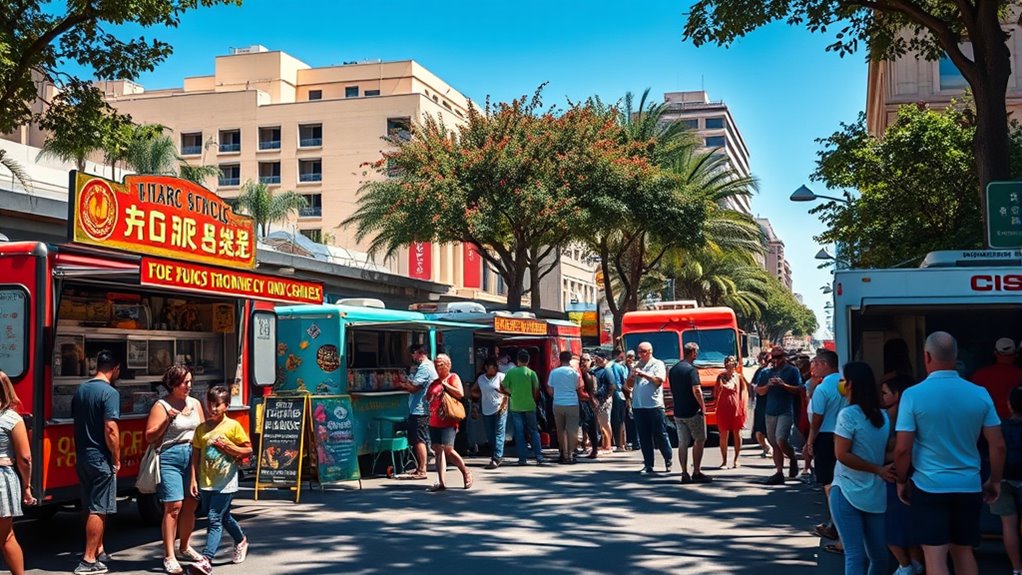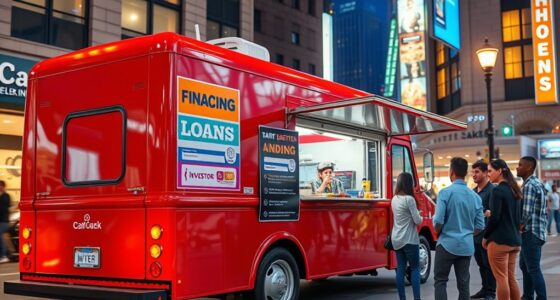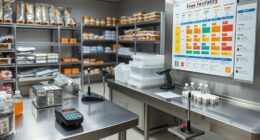To forecast revenue and profit for your food truck, analyze past sales data to spot trends and customer preferences. Incorporate seasonal patterns and weather impacts, adjusting your plans accordingly. Evaluate your location’s foot traffic and customer spending habits to refine projections. Use financial modeling tools and technology to improve accuracy. Regularly monitor actual performance against forecasts, making adjustments to stay profitable. Continue exploring these strategies to master your food truck’s financial success.
Key Takeaways
- Analyze historical sales data, customer preferences, and seasonal trends to predict future revenue streams accurately.
- Incorporate external factors like weather, events, and location performance to refine revenue forecasts.
- Calculate costs—including ingredients, labor, and marketing—to determine profit margins and identify areas for optimization.
- Use technology such as POS systems and forecasting software to automate data collection and improve accuracy.
- Continuously monitor actual performance against projections, adjusting plans based on real-time sales and market conditions.
Analyzing Historical Sales Data to Identify Trends

To accurately forecast revenue and profit for your food truck, you first need to analyze your historical sales data. By reviewing past sales, you can identify patterns in customer preferences, peak hours, and popular menu items. This insight helps refine your inventory management, making sure you stock the right quantities and reduce waste. Strong supplier relationships are essential because they allow you to adjust orders based on demand trends, avoiding shortages or excess stock. Tracking sales over time reveals seasonal shifts and special event impacts, enabling you to plan inventory and staffing more effectively. Regularly analyzing this data also helps you spot slow-moving items, guiding menu adjustments that improve profitability. Additionally, understanding your projector technology can help you create an engaging visual environment for your food truck events or promotions. Staying data-driven ensures your food truck operates efficiently and adapts to changing customer needs.
Incorporating Seasonal and Weather Patterns Into Forecasts

Incorporating seasonal and weather patterns into your sales forecasts is essential because these factors considerably influence customer foot traffic and menu preferences. Seasonal fluctuations and weather variability can cause significant shifts in demand. To account for these, consider tracking historical weather data alongside sales trends. Adjust your forecasts by recognizing patterns such as increased foot traffic during summer events or dips during rainy days. You might also tailor your menu offerings based on weather conditions, like offering cold drinks during hot spells. Additionally, understanding digital literacy can help you leverage online tools and apps to monitor weather patterns and customer behaviors more effectively.
Incorporate weather and seasonal trends to refine sales forecasts and optimize staffing and menu planning.
- Monitor local weather forecasts regularly
- Identify recurring seasonal peaks and troughs
- Adjust staffing and inventory accordingly
- Incorporate weather forecasts into your sales models
Evaluating Location Impact on Revenue Potential

The location of your food truck plays a crucial role in determining its revenue potential, as foot traffic and customer demographics vary widely across different sites. To capitalize on a location’s potential, you need to secure proper food truck permits and understand parking regulations. Permits ensure you’re legally allowed to operate in specific areas and can influence the types of locations available. Parking regulations, including restrictions on size, duration, and designated zones, directly impact how often and where you can set up. Choosing a location with high foot traffic, while complying with permit requirements and parking rules, maximizes your sales opportunities. Regularly evaluating these factors helps you identify ideal spots and avoid penalties or operational disruptions. Additionally, understanding electric bike capabilities, such as speed and horsepower, can help you select locations that suit your operational needs and enhance your revenue streams.
Estimating Customer Traffic and Spending Habits

Understanding when and how customers spend is essential for accurate forecasts. You should analyze peak operating hours, identify spending pattern trends, and consider how events influence foot traffic. This approach helps you better predict customer behavior and optimize your food truck’s sales opportunities. Additionally, recognizing public perceptions of celebrity can influence promotional strategies and customer engagement.
Peak Operating Hours
Identifying peak operating hours is essential for accurately estimating customer traffic and spending habits. During peak hours, the crowd density increases, leading to higher sales potential. To pinpoint these times, analyze local foot traffic patterns and your sales data. Consider factors like lunch breaks, evening rushes, and special events. Keep in mind:
- Peak hours typically occur midday and early evening
- Crowd density varies by location and day
- Weekends often see increased customer flow
- External factors like weather impact crowd levels
- Employing data-driven strategies can optimize scheduling and inventory management.
Spending Patterns Trends
Analyzing spending patterns trends helps you predict customer traffic and their purchasing habits more accurately. By observing dining preferences, you gain insights into what types of cuisine or dishes attract more customers during different times or locations. Tracking how spending varies across days, seasons, or events reveals when customers are most willing to spend. Additionally, menu innovations influence spending habits by encouraging customers to try new items or premium options, increasing average ticket sizes. Understanding these trends allows you to tailor your offerings and marketing efforts effectively. Recognizing shifts in customer preferences helps optimize inventory and pricing strategies, ensuring you meet demand and maximize revenue. Incorporating beetroot recipes into your menu can also attract health-conscious customers and diversify your offerings, enhancing overall profitability. Staying attuned to these patterns is essential for making informed decisions and sustaining long-term profitability.
Event Impact Analysis
Events can considerably boost customer traffic and alter spending habits for food trucks. Food truck festivals and promotional events attract large crowds, increasing sales opportunities. To estimate customer traffic, consider factors like event size, location, and timing. During these events, your sales volume often spikes, but spending habits may shift toward higher-value orders or additional purchases. Recognizing signs of narcissistic behavior in event organizers or participants can help manage interactions more effectively.
- Analyze past attendance data and event popularity
- Monitor social media buzz and promotional activity
- Track sales spikes during similar events
- Adjust staffing and inventory based on expected traffic
Applying Financial Modeling Techniques for Food Trucks

To effectively forecast your food truck’s financial performance, you need to analyze key revenue drivers and understand your cost structure. Applying financial modeling techniques helps you identify profit margin strategies that maximize your earnings. By focusing on these points, you can make smarter decisions to improve your truck’s profitability. Incorporating grocery savings strategies can also help reduce overall expenses and boost profit margins.
Revenue Drivers Analysis
Understanding the key revenue drivers for food trucks is essential to building accurate financial models. Your success depends on identifying factors that influence sales volume and pricing. Focus on aspects like:
- Kitchen equipment efficiency, which speeds up service and increases customer turnover
- Menu innovation to attract repeat customers and stand out from competitors
- Location choices that maximize visibility and accessibility
- Seasonal or event-driven opportunities that boost sales on specific days
- The impact of spoiled ingredients on customer satisfaction and repeat business
Cost Structure Breakdown
Breaking down the cost structure of a food truck is essential for creating accurate financial models. Your primary expenses include ingredient sourcing, which affects food costs and profit margins. Track how much you spend on ingredients, and identify suppliers offering the best prices without compromising quality. Marketing expenses are also critical; these include social media ads, promotions, and branding efforts that attract customers. Understanding your marketing costs helps you allocate budgets effectively and measure return on investment. Other fixed costs include truck maintenance, licensing, and labor. By categorizing these expenses precisely, you can forecast your break-even point and identify areas to optimize for better profitability. Accurate cost breakdowns enable you to develop realistic financial projections and make informed decisions. Additionally, considering the effectiveness of eye patches can serve as a metaphor for assessing which expenses truly add value to your operations.
Profit Margin Strategies
Implementing effective profit margin strategies is essential for maximizing your food truck’s profitability. Focus on enhancing your margins through tactics like menu innovation, which allows you to introduce high-margin items that attract customers and boost sales. Strengthen your branding strategies to create a loyal customer base that’s willing to pay premium prices. To improve your profit margins, consider:
- Offering unique, signature dishes that differentiate your truck
- Streamlining operations to reduce waste and control costs
- Adjusting pricing based on customer preferences and demand
- Promoting menu items with higher profit potential through marketing
- Utilizing affiliate partnerships to expand your revenue streams and leverage additional income sources without increasing costs
Utilizing Technology and Software for Accurate Predictions

Leveraging technology and software tools can substantially improve the accuracy of revenue and profit forecasts for food trucks. By analyzing data from mobile payments, you gain real-time insights into customer preferences and peak hours. Social media analytics help predict demand trends and identify popular menu items. Tools like POS systems and forecasting software automate data collection, reducing manual errors. Consider integrating platforms that track online reviews and engagement to anticipate customer turnout. Use this combined data to refine your sales projections. Additionally, incorporating predictive analytics can further enhance forecasting accuracy by identifying future sales patterns based on historical data.
Monitoring and Adjusting Forecasts for Optimal Results

After harnessing technology and software to generate initial forecasts, it’s important to continuously monitor actual performance against these predictions. This helps you identify gaps and modify strategies promptly. Keep a close eye on inventory management to prevent shortages or excess stock, which impacts profitability. Regularly review staff scheduling to match demand, ensuring efficient service without overstaffing. Use real-time sales data to compare against forecasts, making necessary corrections. Adjust marketing efforts if sales underperform or overshoot expectations. Tracking these metrics allows you to fine-tune your operations, maximize revenue, and improve profit margins. Staying proactive ensures your food truck remains agile, responsive, and aligned with evolving customer trends. Incorporating mental clarity and health practices can also enhance decision-making and operational focus. Regular adjustments keep your forecasts accurate and your business thriving.
Frequently Asked Questions
How Do New Competitors Affect Revenue Predictions for Food Trucks?
New competitors impact your revenue predictions by shifting the competitive landscape. You need to perform a thorough competitive analysis to understand their offerings, pricing, and location strategies. As new trucks enter the market, customer loyalty may decline if they switch to competitors with better options or prices. This change can lower your revenue forecasts, so staying adaptable and focused on unique value propositions helps maintain your customer base and long-term profitability.
What Legal or Regulatory Changes Could Impact Profit Forecasts?
Legal and regulatory changes like zoning restrictions and health regulations can substantially impact your profit forecasts. Zoning restrictions might limit where you can operate, reducing your customer base, while stricter health regulations could increase your compliance costs. Staying informed about local laws helps you adapt quickly, ensuring you maintain profitability. You’ll need to plan for potential restrictions or increased expenses to keep your food truck business thriving.
How Do Marketing Strategies Influence Customer Traffic and Sales?
You realize that marketing strategies like social media and promotional campaigns directly boost customer traffic and sales. By engaging customers online, you create buzz and attract more foot traffic. Well-executed promotions encourage repeat visits and word-of-mouth referrals. With consistent social media presence, you keep your food truck top of mind, increasing sales and loyalty. These strategies are essential for maximizing your revenue and ensuring long-term success in a competitive market.
What Costs Are Most Variable and Hardest to Predict Accurately?
You’ll find that variable costs like supply chain expenses and equipment maintenance are the hardest to predict accurately. Supply chain disruptions can suddenly increase ingredient costs, while unpredictable equipment repairs might cause unexpected expenses. These costs fluctuate based on factors outside your control, making budgeting tricky. Staying flexible with your forecasts and building a contingency fund can help you manage these unpredictable costs effectively.
How Can Economic Shifts or Inflation Impact Future Profitability?
Like a storm on the horizon, economic downturns and inflationary pressures threaten your food truck’s future profits. These shifts can cause costs to rise unexpectedly and reduce customers’ spending power. You might find your revenue shrinking just when you need it most. Staying adaptable and monitoring economic trends helps you navigate these turbulent waters, ensuring you can adjust prices or menu offerings to weather the financial storm.
Conclusion
By mastering these forecasting strategies, you’ll open the secret to turning your food truck into an unstoppable revenue-generating machine. With perfect predictions, you’ll outsmart weather surprises, outmaneuver competitors, and dominate every location like a culinary superhero. Imagine knowing exactly when and where customers will swarm your truck—your profits will soar higher than you ever dreamed. Get ready to revolutionize your food truck game and make your financial success unstoppable!









